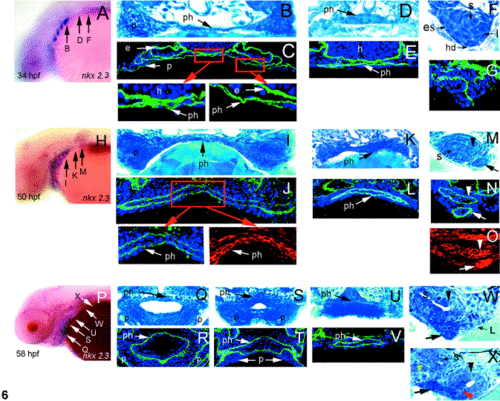Fig. 6
|
Zebrafish pharynx and esophagus development: morphogenesis and cell polarization. (A?G) 34 hpf. (A) Lateral view of nkx-2.3 expression within the branchial arches with corresponding histological sections (B, D, F). (B) The anterior pharynx is comprised of a single layer of endoderm. Caudally, the endoderm of the posterior (D) pharynx is stratified. (F) Tissue compartmentalization is seen within the region of the developing esophagus. Analysis of caudal serial sections from this and subsequent stages identifies the primordia of the esophagus (e), liver (l), swimbladder (s), and hepatic duct (hd). (C, E, G) 34-hpf laminin immunostainings. At this stage, laminin surrounds individual cells within the anterior and posterior pharynx (C, E) and tissue compartments near the esophageal primordium (G). (H?O) 50 hpf. (H) Lateral view of nkx-2.3 expression. Tissue sections (I) and immunostainings with laminin (green, J) and cadherin (red inset, J) reveal an epithelial bilayer within the anterior pharynx. The posterior pharynx remains stratified (K) and is clearly surrounded by laminin within the developing basement membrane (L). Organization of the esophagus primordium (arrowhead) and swimbladder pneumatic duct (s) is now evident in tissue sections (M) The esophageal epithelium (arrowhead) is now also polarized (N, O). Note also laminin and cadherin in the hepatic duct (arrow). (P?X) 58 hpf. (P) Lateral view of nkx-2.3 expression. (Q) The lumen of the rostral anterior pharynx is visible in tissue sections as are nearby ventral gill slits. (S) The lumen of the anterior pharynx narrows caudally. Note ventral location of the pharyngeal arches in this region (p). (U) The lumen of the posterior pharynx, near the esophageal border, is filled with amorphous debris and difficult to appreciate in tissue sections. (W) At this stage, the esophageal (arrowhead) and swim bladder pneumatic duct (s) lumens are clearly patent. Liver (l) and hepatic duct (arrow) are also seen in this section. Caudally (X), the hepatic?pancreatic duct (red arrowhead) inserts into the developing intestine (black arrowhead). Developing exocrine pancreas (black arrow) and pancreatic islet (yellow arrow) are evident in this section. (y, yolk). (R, T, V) Immunoreactive laminin surrounding the pharynx. In all panels: h, hindbrain; e, ear; p, brancheal arches; ph, pharynx; s, swimbladder; hd, hepatic duct; l, liver; es, esophagus. |
| Gene: | |
|---|---|
| Antibodies: | |
| Fish: | |
| Anatomical Terms: | |
| Stage Range: | Prim-15 to Long-pec |
Reprinted from Developmental Biology, 255(1), Wallace, K.N. and Pack, M., Unique and conserved aspects of gut development in zebrafish, 12-29, Copyright (2003) with permission from Elsevier. Full text @ Dev. Biol.

